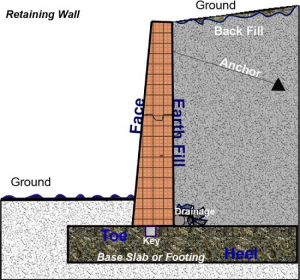Australia Retaining Wall Blocks
A retaining wall that is stacked helps to prevent soil from sliding down the slope. Blocks can be stacked with a maximum height of 36 inches depending on its size. The interlocking wall is easy to make and will hold as much as 1000 pounds for each square feet. Retention wall blocks could be as tall as 36 inches, based on its size. A retainer brick as high as 8 inches deep.
Resilient wall blocks make a wonderful solution to help reclaim land that is sloped. These systems not only retain soil, they can also improve the properties aesthetic appeal. There are a variety of shapes, sizes and colors available. The blocks are very easy to stack. For a curved retaining wall The Junior Block may be a ideal choice. The Allan block is the more affordable option and also ideal for use in residential settings.

A standard block is not very attractive in value, but you can decorate it with an appealing layer of veneer for an added appeal. The durability of walls for retaining can’t be questioned, thanks to their unobtrusive appearance. Most structural engineers will require an additional layer of block on walls more than 4 feet in height. Though standard block is not an attractive option, it does offer excellent strengthening properties to the structure. After installation, the standard bar will run through the foundation before being integrated into the cells.
They can also be used in the construction of diy retaining walls. The block is versatile and can be utilized to build curving garden walls. Duostone blocks are multi-piece walls for retaining which are available in five dimensions. They also have a natural, stacked stone style. These retaining wall block systems are ideal for DIY preserving walls. They are readily available in local hardware stores or bricklayer.
You can find retaining wall blocks available in a range of textures, colours and even natural stone. They are lightweight and simple to put in. You can stack them without cement mortar or concrete. They can be found in various dimensions. They’re also easy to move, unlike traditional wall retaining blocks, and don’t have to be fixed. Although they’re popular, walls that enclose retaining aren’t an ideal choice to construct a curving wall.
For creating unique spaces for outdoor use, retaining wall blocks can be a great alternative. You can use retaining walls for gardens with raised beds or slopes that are terraced. They can create a beautiful landscaping and also create privacy. They can also create areas. The retaining block is an ideal option when you creating DIY walls for retaining. You can add it to the garden bed that is raised or create a stepping pathway made of stones.
There are numerous kinds of retaining wall block. Some are vertical, while others have a split face. They could be used to create walls to reclaim land. The majority of them are made up to a size of one meter with no construction. If you’re looking for a larger wall, you can use an masonry block that has the frame of steel. Some kinds of retaining wall blocks are more sturdy than others.
An excellent option for creating an impressive retaining wall can be made using blocks for retaining walls. Some of the styles of walls for retaining are suitable to complete a range of designs. For instance, a brick block could be utilized to create a path for the garden. Additionally, it could be a retaining wall block for sloped lawns. This wall is made of concrete that is a retaining. It’s easy to put up and is a cost-effective option for a retaining a garden.
Blocks for retaining walls made of concrete come in a variety of colors and textures. They are perfect to create a wall of retaining because they can be assembled fast and easily interlocked with the other edges. They’re strong and long-lasting, and could be used to solve kinds of grade issues. These blocks can be used for a wide variety of purposes and could even be stackable with clips or masonry tools. It is possible to select the kind of retaining wall block that complements the pavers that you are using.
Another popular use for walls that reshape the retaining area is to construct steps or conceal utilities using an retaining wall block. A retaining wall can also be utilized to construct the pillars, garden wall or retaining wall that is four inches in height. Materials and equipment required for a garden retaining wall can vary from bricks to pavers and can be customized to fit your needs. If you are interested in creating a retaining walls you should engage a professional.